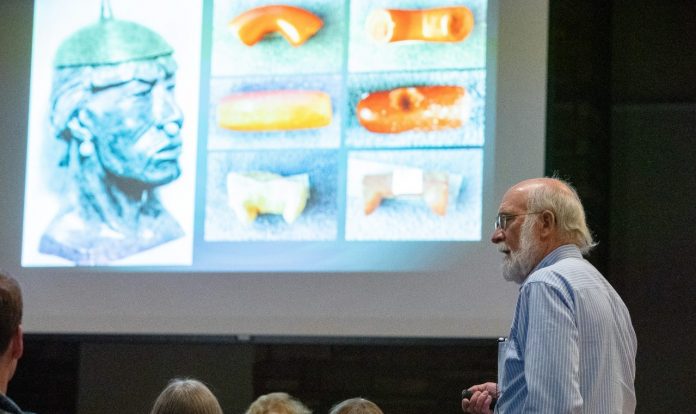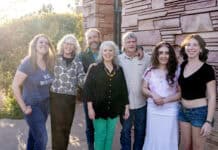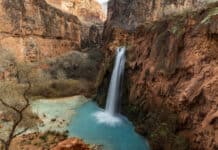
Coconino National Forest archaeologist of 45 years, Peter J. Pilles Jr., spoke at a Sedona Gem and Mineral Club meeting on Feb. 18 on the pre-Columbian Sinagua’s use of minerals.
Much of his talk highlighted the ancient people’s use of color, since minerals were a major source of color.
By Pilles’ account, the Sinagua led color-filled lives, bringing it into their world through a variety of means.
The Sinagua — a modern name applied to people who lived in the Verde Valley and the Flagstaff area between A.D. 650 and 1400 — painted blankets and baskets, tie dyed cloth and tinted it with red hematite powder, Pilles said. Some Sinagua wore orange nose plugs of argillite, occasionally embellished with buttons of contrasting stone. They inlaid shells with fragments of turquoise and red stone to create bird and toad mosaics.
Pilles also said archaeologists wondered for a long time how the Sinagua stored their mineral pigments, but they have since found dried canes filled with blue powder and Pacific sea shells filled with green powder, suggesting some means of keeping the precious colors.
Though hard evidence doesn’t exist, he said it is likely that pre-Columbian Verde Valley residents embellished their bodies with paint.
The intensity of color in the objects Pilles shared on the projector seemed to impress many at the Sedona Gem and Mineral Club meeting held at the Sedona Public Library.
After seeing pictures of an elaborately painted blanket from the Verde Valley in Pilles’ slide show, a surprised audience member asked whether or not the Sinagua used a written language.
Though the Singua did not use a writing system, Pilles explained, “These were not primitive savages … They were very sophisticated people.”
In addition to the extensive use of color in the Sinagua world, another theme in Pilles’ talk was the uniqueness of the Verde Valley within the ancient Southwest.
Pilles said that textile experts have told him that some of the finest weaving in the ancient Southwest was produced in the Verde Valley. To support the point, he shared a photo of a cotton blouse with an intricate open-weave pattern found in the Sycamore Canyon area; it could have come off a modern store rack.
Frequently, Pilles showcased classes of artifacts found in the Verde Valley and only a few other places in the Southwest. Examples of these rare artifacts include painted baskets, tie dyed cloth and copper bells.
Pilles made a convincing case that the Sinagua had a deep appreciation of color, but he cautioned that the ancient people probably attached significance to colors that are difficult for non-Natives to understand today.
“They didn’t just use these colors because they were pretty,” he said.
The Verde Valley Archaeology Center curates many examples of the Sinagua’s skill in weaving and use of color in the Paul Dyck collection, currently on display at their museum at 385 S. Main St. in Camp Verde.
The Sedona Gem and Mineral Club regularly hosts speakers at their monthly meetings on the third Tuesday of the month at the Sedona Public Library.





















